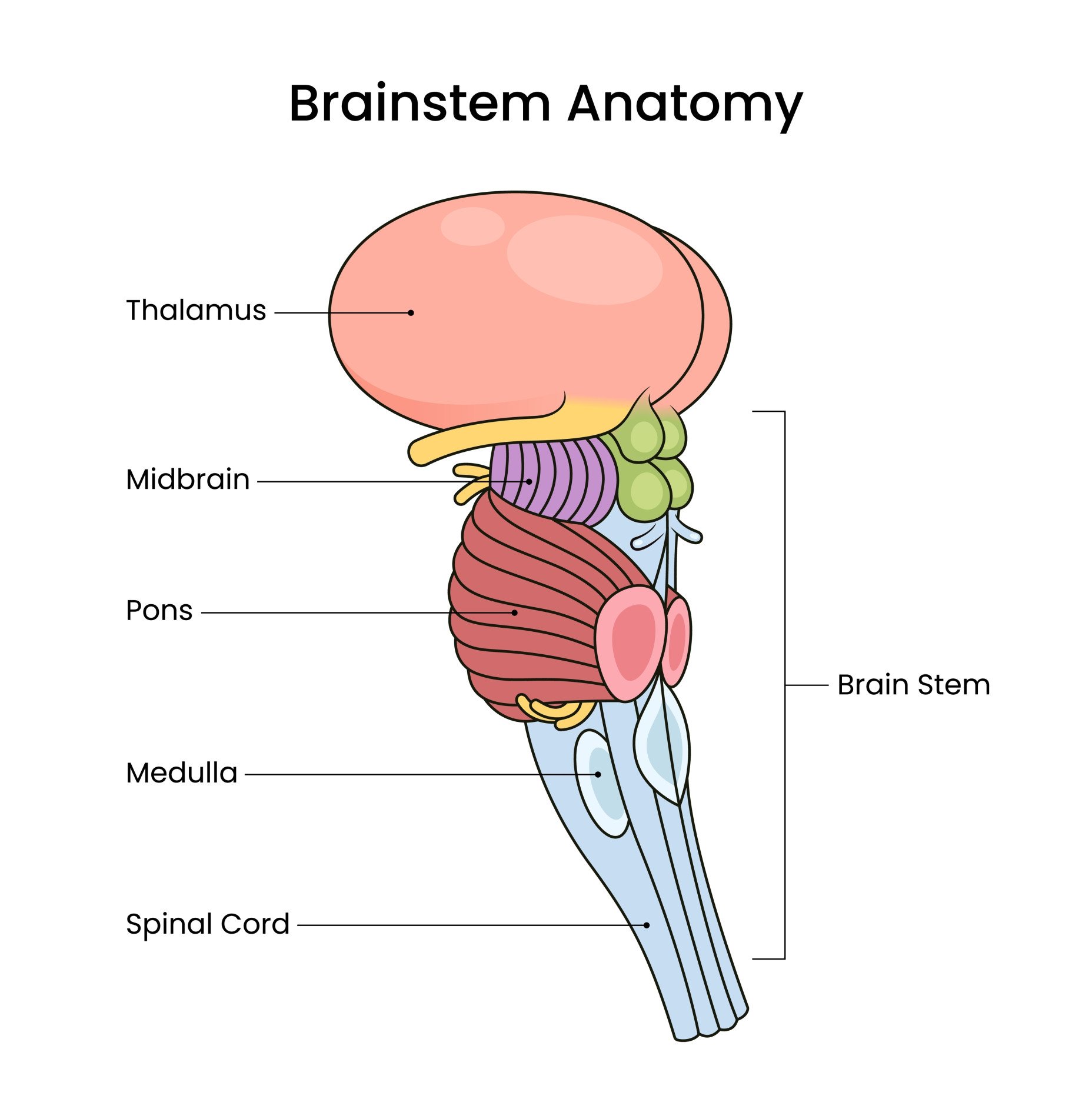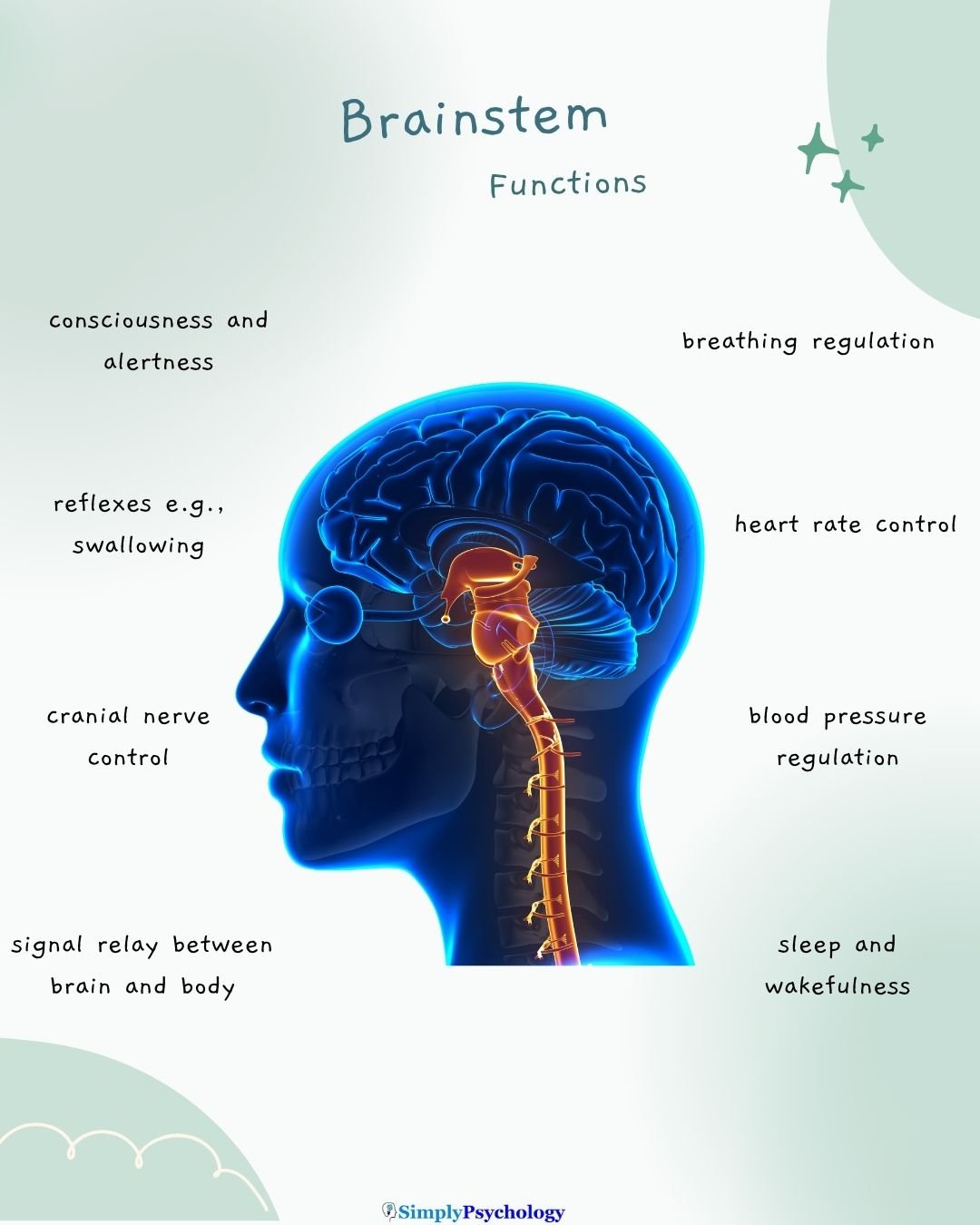The brainstem is the stalk-like lower part of the brain that connects the main brain (cerebrum) to the spinal cord. It sits at the base of the skull, just above the spinal cord, and is considered part of the central nervous system (CNS).
In plain language, the brainstem is like the body’s life support system – it controls basic functions that keep you alive.

The brainstem has three major parts: the midbrain, pons, and medulla oblongata. Each of these parts plays a different role (explained below), but together they manage functions you don’t have to think about – things like breathing, heart rate, and consciousness.
Because it contains critical nerve pathways, the brainstem also links the brain to the rest of the body, carrying messages to and from the spinal cord.
Key Takeaways
- The brainstem connects the brain to the spinal cord and regulates automatic, life-sustaining functions.
- It controls breathing, heart rate, blood pressure, consciousness, and reflexes like swallowing.
- It acts as a communication bridge between the brain and body.
- Most cranial nerves emerge from the brainstem, supporting facial movement, hearing, and swallowing.
- In psychology, the brainstem is essential for consciousness, sleep, and instinctive survival behaviors.
- Damage can result in coma, paralysis, or death, showing how vital the brainstem is to everyday functioning.
Main Functions of the Brainstem
The brainstem controls many automatic, life-sustaining functions that keep us alive without conscious effort. It works as the body’s autopilot for critical processes. Key functions of the brainstem include:
- Breathing: Regulates the rate and depth of breathing. Neurons in the medulla (with help from the pons) automatically control our breathing rhythm.
- Heart rate & blood pressure: Adjusts heartbeats and blood vessel diameter to maintain blood pressure. The medulla contains cardiovascular centers that manage heart rate and blood pressure reflexively.
- Sleep and arousal: Maintains consciousness, alertness, and sleep cycles. The brainstem’s reticular activating system (RAS) stimulates wakefulness and helps regulate the sleep-wake cycle.
- Reflexes: Coordinates involuntary reflex actions like swallowing, coughing, gagging, and blinking. For example, the brainstem triggers the gag and swallowing reflex to protect your airway, and adjusts pupil size in response to light.
- Relay of signals: Serves as a communication bridge between the brain and body. All sensory information from the body to the brain (touch, pain, etc.) and motor commands from the brain to muscles pass through the brainstem. It’s like a two-way highway for nerve signals, ensuring the brain and body stay connected.
These functions happen automatically. You do not have to “think” to breathe or keep your heart beating – your brainstem handles it in the background, which is why it’s crucial for survival.

Parts of the Brainstem
The brainstem is made up of three main parts. Each part has specific structures and roles:
Midbrain (Mesencephalon)
This is the upper part of the brainstem. It controls eye movements and certain reflexes to visual and auditory stimuli. It also houses dopamine-producing neurons (e.g., substantia nigra) important for movement and reward.
Pons
The pons is the middle section of the brainstem (its name means “bridge”). It helps regulate breathing by working with the medulla to maintain a smooth respiratory rhythm.
It serves as a bridge linking the cerebellum with the rest of the brain, and relays signals for facial movement and sensation, as well as for hearing and balance.
Medulla Oblongata
The medulla is the lowest part of the brainstem, directly continuous with the spinal cord. It controls critical automatic functions: it regulates heart rate, blood pressure, and breathing.
It also manages reflexes like swallowing, coughing, sneezing, and vomiting. Because the medulla governs such vital processes, damage to it can be fatal.

Cranial Nerves and the Brainstem
Twelve pairs of cranial nerves arise from the brain to control the head and internal organs. Importantly, 10 out of the 12 cranial nerves originate in the brainstem (cranial nerves III through XII).
In simpler terms, most nerves that let you blink, smile, cry, hear, taste, speak, and swallow can be traced to nuclei (nerve control centers) within the brainstem.
The brainstem acts as a command center for these cranial nerves, sending signals between the brain and the face, throat, and sensory organs.
This is why damage to the brainstem can cause widespread problems – it can affect hearing, balance, facial movements, and even basic abilities like swallowing or speaking.
Why the Brainstem Matters in Psychology
In psychology and neuroscience, the brainstem is seen as the foundation for consciousness and basic survival behavior.
The reticular formation, particularly the reticular activating system (RAS), plays a key role in alertness, attention, and wakefulness. Damage to this area can lead to coma, as the brain’s internal “alarm system” shuts down.
Because it governs such basic, automatic functions, the brainstem is sometimes called the “reptilian brain.”
The brainstem works closely with the autonomic nervous system to produce physical reactions to emotions. For instance, during fear, the limbic system signals the brainstem to trigger a fight-or-flight response—faster heart rate, rapid breathing, and more.
In short, the brainstem supports automatic responses that form the basis of more complex behaviors. Without it, higher thinking processes can’t occur, making it essential for both survival and psychological functioning.
Disorders and Damage to the Brainstem
Because the brainstem controls vital functions, injuries can be life-threatening. A brainstem stroke may cause locked-in syndrome, where a person is fully conscious but paralyzed except for eye movements.
Severe damage—whether from trauma, swelling, or disease—can result in coma or brain death. Since the brainstem controls breathing and consciousness, damage may cause loss of awareness and inability to breathe independently. In cases of brainstem death, recovery is not possible.
Other symptoms of brainstem damage include:
- Difficulty swallowing
- Impaired balance
- Slurred speech
- Paralysis
Recovery is often limited, and many brainstem injuries require urgent life support. Even survivors may face lasting disabilities.

